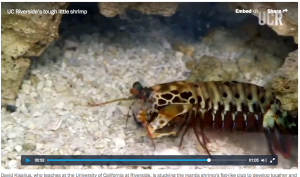New Book I’m Agenting Points to Breakthroughs in Designing & Building a State-of-the Art Military Helmet
 According to a science article by Washington Post reporter Ben Guarino, the claw of the mantis shrimp packs a wicked punch in dispatching its prey, and has even been known to split or amputate the thumbs of unlucky fishermen. But for me the most remarkable part of this fascinating article regards the material of the claw, or club, as it’s also described in the story:
According to a science article by Washington Post reporter Ben Guarino, the claw of the mantis shrimp packs a wicked punch in dispatching its prey, and has even been known to split or amputate the thumbs of unlucky fishermen. But for me the most remarkable part of this fascinating article regards the material of the claw, or club, as it’s also described in the story:
This startling book, written by two authors who’ve covered the Pentagon for many years, reveals that in the twenty-first century, while traumatic brain injury (TBI) has become the signature injury suffered by our troops, the defense establishment has failed US fighting men and women by continuing to issue them an antiquated military helmet that fails to mitigate the worst of this tragic harm, even though superior design and technology are available.
This investigation by Dina Rasor and Robert Bauman, the first book to examine this most basic item of military equipment, features the stories of two sets of whistleblowers determined to expose the truth about the failures military helmet bureaucracy. Their book braids together the two stories to chronicle the helmet scandal and its human impact.
Readers will learn about retired Navy doctor Robert Meaders, known affectionately as “Doc Bob.” He began helping his grandson obtain protective pads that deterred the blunt force and blast wave impact caused by improvised explosive devices (IEDs). These pads made even the standard issue combat helmet more protective than they were without them. Soon, frustrated by his futile efforts to convince the Marine Corps’ bureaucracy in Washington DC to add these protective pads to the helmets of combat troops in Iraq and Afghanistan, and receiving an avalanche of requests from many Marines for them, he started a nonprofit organization, Operation Helmet, to raise funds so the pads could be provided to the troops free of charge. Despite the improvements his pads offered, Doc Bob was blackballed from the military procurement system
Tammy Elshaug and Jeff Kenner, longtime employees of North Dakota defense contractor Sioux Manufacturing discovered to their dismay that the required density of the Kevlar material woven into netting supplied by Sioux for combat helmets was being shorted in the plant where they worked. Bringing their discovery to the attention of management—believing the boss would surely clean up the illegal practice—they were instead accused of stealing company secrets and having an adulterous affair. Both were fired, leading to a lawsuit and a judgment they won in court that brought the company’s bad faith practices to light.
Doc Bob did not know about Jeff and Tammy and they did not know about him. Yet all three struggled during the same time period to do what was right for the troops. This book chronicles, interwoven to show the courage and dedication of all three, and also, to explain why the Defense Dept, despite news coverage of their revelations, has continued to do the indefensible. The authors use all their years of reporting and investigative experience to explain to readers and policymaker how this could happen. Critically, they also offer information on how the public, press and the military departments can fix the problem and give US troops a better combat helmet that will help them survive their service and continue contributing to the defense of the United States of America.
Upon publication the authors will write op-eds and columns that offer an open challenge to technologists, designers, 3D printers, materials scientists, and high level defense thinkers to finally design the best possible military helmet. Despite the Pentagon’s failure to this point, we also hope to gain their attention to bring new talent and focus to the goal. In the same regard, we are excited about the effort being undertaken by the Head Health Challenge, which also relates to football helmets, an effort that has been covered by Liz Stinson in Wired magazine. I’m hopeful we’ll be able to forge a constructive link between the Defense Dept and the NFL with this initiative to design and build a superior helmet. I recommend you read the marvelous article by Ben Guarino, which also has video from UC Riverside scientist David Kisailus.
